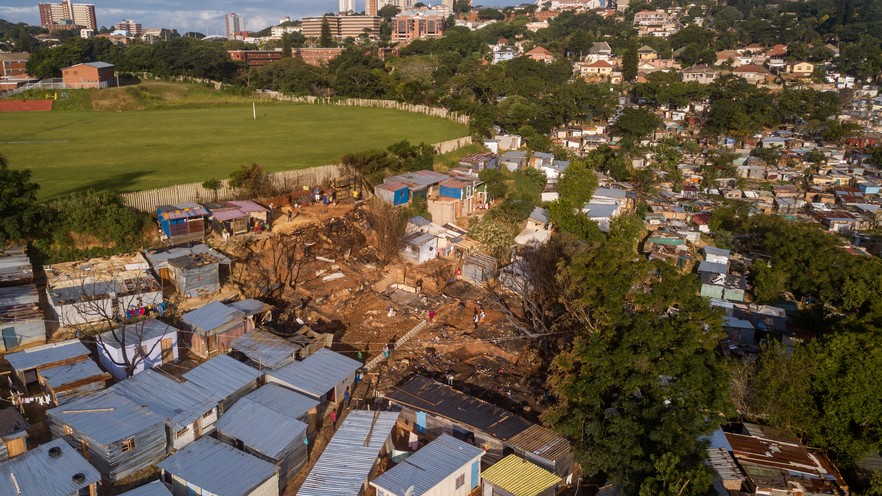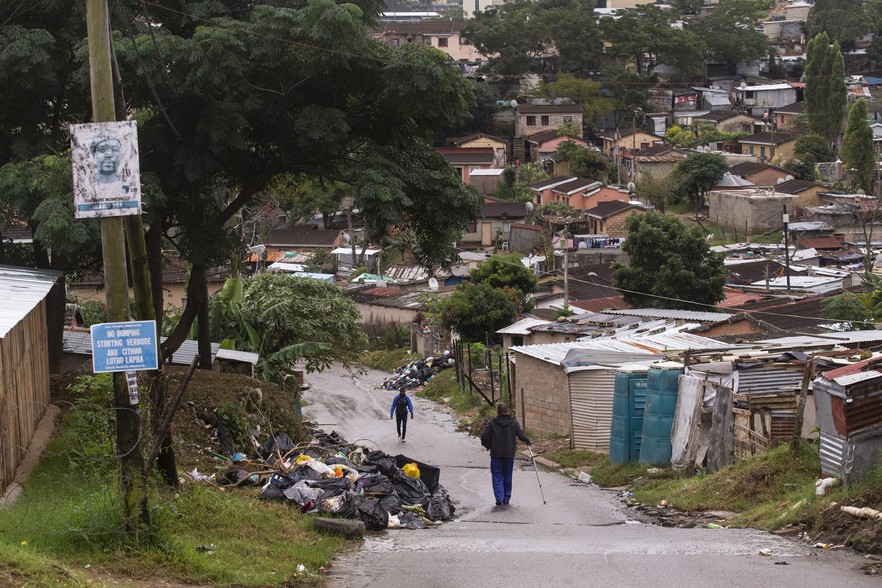
Bloody Battle for Land and Rights in Cato Manor
Although the area is notorious for violence and assassinations, there are many residents working together to make it a better place. By Greg Arde and Benita Enoch. In the shack lands of Cato Manor in Durban, everything is a hustle. If you want to find a room, you have to know someone. If you want to […]

Although the area is notorious for violence and assassinations, there are many residents working together to make it a better place. By Greg Arde and Benita Enoch.
In the shack lands of Cato Manor in Durban, everything is a hustle. If you want to find a room, you have to know someone. If you want to connect to illegal electricity, you have to pay someone.
Cato Manor is a crowded slum with little access to running water and flush toilets. Many residents relieve themselves in plastic bags which the municipality sometimes collects.
On the edge of Durban’s central business district, Cato Manor has been in the news for all the wrong reasons, including the murder of a councillor candidate and housing activists.
The area spans three municipal wards. Most people live in shacks. The number of people is hard to estimate – over 90,000, according to the Cato Manor Development Association (which is now defunct). The shacks are crowded together and stretch for kilometres on either side of the M10. Some teeter dangerously close to the main road, others balance precariously on slopes. There have been numerous fatal fires and when it rains, Cato Manor becomes a messy bog.
Residents tolerate the overcrowding, shared and scarce toilets, crime, and pollution to save money by being close to jobs, hospitals, schools, and other amenities. And every month poor rural people flock to the shantytown to join them.
Most houses are illegally connected to the grid in a tangle of dangerously low-hanging wires and there have been many fatal electrocutions, including of children.
Residents pay up in order to survive. An illegal electricity connection to the grid costs R300. Thereafter, shack dwellers pay connected locals R120 a month for the stolen electricity.
The Cato Manor shacklands are among nearly 600 informal settlements in eThekwini which the municipality says house upwards of 280,000 residents altogether, although that is a contested figure.
Shackdwellers’ movement Abahlali baseMjondolo is well-organised in the area, with strongholds in the Cato Manor neighbourhoods of Marikana, Azania, eNkanini and eKhenana.
Assassinations
Abahlali members are outspoken critics of the ruling ANC and have suffered for it. Since 2014, the movement says, eight of its members have been killed, including three of its leaders who lived in eKhenana.
The latest victim was Lindokuhle Mnguni, who was shot dead inside his home on 17 August. Mnguni was one of three Abahlali members arrested for the murder of eKhenana resident Vusi Shandu earlier this year. The charges were dropped, but Mnguni spent six months in Westville prison, awaiting a bail hearing.
Abahlali has put eKhenana under CCTV surveillance, according to Mqapheli Bonono, the movement’s deputy president. He says evidence collected from the cameras, together with eyewitness accounts, will be presented in court at the next opportunity. “We electrified the place and we’ve even put up fencing and barbed wire. So, we know who the killers are. We are still building our legal case.”
An eThekwini councillor, who spoke to GroundUp anonymously for fear of retaliation, says politicians in the area have their eye on the land for a lucrative housing development. This is why Cato Manor is valuable to politicians, he says.
“I don’t have bodyguards. When you tackle people on this topic, one must tread carefully. There is a very dangerous situation here with people in the ANC in eThekwini who stand to lose a lot if eKhenana and other informal settlements stay where they are,” said the councillor, who claims to have inside knowledge of the political motive for three eKhenana-related murders.
Even within the ANC, a bloody battle for the area has taken place.
In May, ANC councillor Mzi Ngiba was one of four men arrested for the murder of his one-time friend and comrade Siyabonga Mkhize.
Ngiba lost an internal ANC contest to Mkhize who was nominated to replace him as the candidate for the November 2021 local government elections. Mkhize won the seat, but by October, he was dead. Ngiba, who was next on the party’s list, secured his old seat and with it access to power and patronage he had become accustomed to since 2011 when he first served as a councillor.

Residents of Cato Manor were afraid to speak about Ngiba to GroundUp. Those who did speak are mostly Abahlali members hostile to him, who say he is a strongman tied in with local gangsters. They say he has key influence over the allocation of government housing.
Abahlali members say ANC heavyweights are tied to taxi hitmen and there are numerous mafia-type rackets. Public land and low cost housing are sold illegally and there is no transparency in the process. Abahlali accuses the eThekwini municipality of refusing to secure wide public engagement for its plans for housing, meaning poor people in particular cannot improve their living conditions or participate in solutions. They say there is no oversight to let the public determine whether the municipality keeps accurate housing lists, who lives in shack settlements, and who receives subsidised housing.
Community efforts
For many Abahlali members, the creation of what they call a commune, in eKhenana, offered an antidote to poverty, deprivation and violence.
Here people live together sharing vegetable gardens, a poultry farm and even an educational centre. But since 2018, and with the murder of several — Abahlali says eight — eKhenana leaders, the commune’s population has dwindled from 100 families to fewer than 40.
At eNkanini, retaining walls were built out of old tyres, a community crèche was put up. A hall was also erected. And an Abahlali member tapped into the city’s water to create a flush toilet.
During Covid lockdown, residents Vusi Mazula and Nhlanhla Mtshali shrugged off the city’s housing failures telling GroundUp that while they wanted to engage with authorities, waiting for feedback was pointless. So they simply got on and built their homes and community facilities. Building materials for a 12m2 shack cost about R3,500 and the structure can be erected in a matter of days.
Mazula and Mtshali said the community spirit activated by Abahlali in eNkanini tapped into the energy and resourcefulness of people and empowered shack dwellers.
Mazula, who ran a small shop, said that in four years eNkanini had quadrupled in size because land was vacant, housing scarce and the area was close to town.
“It is crowded. This is my space, but you can’t have a selfish heart. I can’t let my brother sleep on the road. We are battling. We tried to manage it (the influx of people) tightly in the beginning, but it is impossible to stop people from coming.”
Mazula said during Covid the municipality installed eight mobile toilets in the area around his house. “The toilets are for about 800 people. We are lucky. Across the road there are no toilets.”
Mtshali said the municipality installed five rain tanks in the Covid lockdown. “We asked for more. The government keeps on promising but most of what you see has been done by ourselves.”
GroundUp reached out via email, phone and SMS to the ANC in eThekwini, Mayor Mxolisi Kaunda and the eThekwini municipality for comment regarding Abahlali’s allegations, as well as plans for housing and service delivery, but no response was received.
A brief history of Cato Manor
Cato Manor is the Durban version of Cape Town’s District Six and Joburg’s Sophiatown, according to Dr. Mphumeleli Ngidi, a history lecturer at the University of KwaZulu-Natal.
It is one of the city’s oldest informal settlements. According to the now-defunct Cato Manor Development Association, Cato Manor was named after Durban’s first mayor, George Cato, who was given land there in 1845 to compensate him for a beachfront property that was expropriated. Shack settlements sprung up in the area because shack letting was “popular and profitable” and by 1943 the population of shackdwellers was 17,000. After the 1949 “Durban riots”, many Indian residents left the area which by now contained 6,000 shacks housing more than 45,000 people.
Ngidi said the area had once enjoyed economic liberty through several home industry efforts, including homebrewed beer made by the so-called Shebeen Queens. But, attempts by the government to control economic activities, led to the formation of beer halls which prohibited the sale of beer elsewhere.
In 1959, the apartheid government’s attempts to move African people from Cato Manor to KwaMashu were met with stiff resistance. Boycotts of the government-controlled beer halls led to liquor raids and riots and in 1960, nine policemen were killed in Cato Manor.
But by 1968 the area had been cleared of all but a few houses, shops, and Hindu temples.
By the 1980s major portions of Cato Manor had been officially identified for Indian settlement. The informal settlement mushroomed, especially in the valley dissected by the M10 but also up the banks of the hills demarcated by apartheid planners for whites and Indians.
Additional sources: Cato Manor Development Agency and South African History Online.
© 2022 GroundUp.
